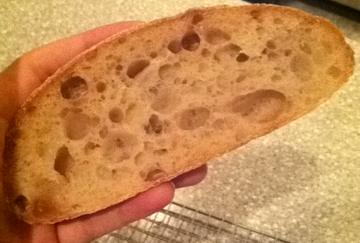I have two bannetons: one oblong, one round. For the past few weeks, I've been making one big batch of sourdough and putting half in each banneton for the final rise/overnight retard. Both loaves are treated exactly the same way for exactly the same time--and yet, when I bake them, the oblong is always perfectly proofed, and the boule is always severely underproofed! How is this possible?
Does it have something to do with the way the loaf shapes are formed? For the oblong banneton, I shape my dough into a batard, and I do a boule shaping for the round one. Maybe the batard is providing better structure for the rise? It's a pretty lean dough (76% hydration), so maybe it needs all the structural help it can get. That's all I can think of. Any ideas?
UPDATE:
This is a photo from the heel of the batard:

This is from the underproofed boule:

(Sorry about the terrible phone photos, which are giving the impression of grey loaves with no browning on the crust--not the case!)
People have been asking for more details about the baking. I do a bulk ferment at room temp for 2.5 hours, with s&f every 30 min. Then I plop them in the bannetons at room temp for 2 hours or so, and then they go in the same spot in the fridge for 12-16 hours. I don't weigh them, but they look about the same weight. In the morning, I bake them straight out of the fridge, one after the other. The batard goes first, so it's not a question of extra proofing time.
Take two aspirin and In the morning, take the temperature of both doughs. Maybe the dough at the back of the fridge is a very different temperature. Or, maybe you take both out at the same time but bake one after the other so the latter one has more time to proof?
If it is truly the shape, that would be interesting to know. But it seems to me unlikely that it would make such a big difference.
The fridge is not the issue. And the underproofed one was baked last, so that isn't it, either.
Well if both are refrigerated overnight then yeah, shape will definitely have an effect on how long each takes to warm back up to room temperature. Assuming here that the longer narrower battard has a higher ratio of surface to volume than the boule, so it proofs quicker from cold.
Had a related problem when bulk retarding bagel dough. After being taken from the fridge and left sitting on the kitchen counter, it would take ages to warm back up all the way through, even though my apartment was dreadfully overheated. Hand rekneading the dough for the better part of an hour there would still be cold pockets. So I gave up on that method and began shaping the dough into rings before refrigerating. Individual bagels would then proof within 45 minutes — the higher ratio of surface to volume had tremendous impact here.
Agree though there could also be structural differences between the boule and battardes that influence the proof, but that is beyond my [considerable lack of] expertise.
I'm not letting them warm back up to room temperature. They both proof for the same amount of time on the counter and then put in the same spot in the fridge overnight. Then I bake straight from the fridge.
Good way for you to learn how the dough should feel, comparing the feel of one to the other. Not so easy to know how cold dough should feel but this might help. Then Bake the one when it feels like the other.
I use both, round and oval bannetons. Sometimes I decide from the available space in the oven whether I do a boule or a bâtard (I bake larger batches on two tiers). I never saw any difference.
But I don't bake those straight from the fridge, I do the bulk ferment in the refrigerator, not the breads.
Karin
I just saw this tutorial, which explains how and when to use different methods of scoring. Boules and batards are scored differently. I'm not sure where your oval banneton fits.
http://www.thefreshloaf.com/node/31887/scoring-bread-updated-tutorial
When I want a * fast * bread I do the mixing and the Autoyse and S&F every 30 Minutes for 3 hours , than I can put the dough in the fridge go Bulk ferment.
I never let the dough do their final rise in the fridge because I had not so good results that way round.
Not a good rise and with that, not a good crumb.
I always do a Boule though and not a batard but I found out, the way I slash the bread for a more oblong loaf works fine in my Round Dutch Oven.
I hope you can figure out the cause of what is going on.